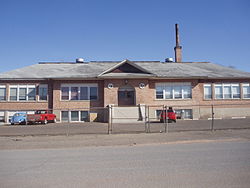Spring Glen, Utah
Spring Glen, Utah | |
|---|---|
 Spring Glen's 1927 schoolhouse | |
 Location in Carbon County and the state of Utah | |
| Country | United States |
| State | Utah |
| County | Carbon |
| Settled | 1878 |
| Founded by | James Gay |
| Area | |
• Total | 3.4 sq mi (8.8 km2) |
| • Land | 3.4 sq mi (8.8 km2) |
| • Water | 0.0 sq mi (0.0 km2) |
| Elevation | 5,761 ft (1,756 m) |
| Population | |
• Total | 1,126 |
| • Density | 330/sq mi (127.4/km2) |
| Time zone | UTC-7 (Mountain (MST)) |
| • Summer (DST) | UTC-6 (MDT) |
| ZIP code | 84526 |
| Area code | 435 |
| GNIS feature ID | 2584777[2] |
Spring Glen is a census-designated place in Carbon County, in eastern Utah, United States. The population was 1,126 at the 2010 census.[4] Founded in 1878, Spring Glen was the first permanent settlement in what is now Carbon County.[5] First settled principally by white Mormon farmers, the community became much more diverse after about 1890, when the development of the area's coal mines brought an influx of immigrants from Southern Europe and other regions.
Geography
Spring Glen lies along the Price River, just to the south of Helper and southwest of Kenilworth. To the southeast are Carbonville and the county seat, Price. U.S. Route 6 runs past Spring Glen between Price and Helper, and SR-139 branches east from it to become Spring Glen Road, the major street through town. According to the United States Census Bureau, the CDP has a total area of 3.4 square miles (8.8 km2), all of it land.[1]
Climate
According to the Köppen Climate Classification system, Spring Glen has a humid continental climate, abbreviated "Dfb" on climate maps.[6] This climatic region is typified by large seasonal temperature differences, with warm to hot (and often humid) summers and cold (sometimes severely cold) winters.
History
The first settlers in Spring Glen were a handful of bachelor farmers, starting with James Gay in 1878. Groups of friends and relatives joined the first few homesteaders, mostly independent minded people who were separate from the organized Mormon project to establish what became Emery County.[7]
As children began to arrive, a school was started in 1883,[8] but such a public development was the exception rather than the rule. The early settlers were nonconformists, less religious and less social than their counterparts in other Utah settlements, so the community was slow to develop. It was difficult to get the residents to cooperate in any communal projects. The LDS Church organized the first ward here in 1883,[7] but it was not until the winter of 1886–7 that a company was formed to build an irrigation canal, which was not completed until 1893.[8] The canal company agreed on the name of Spring Glen for the village as well as the company.[9] The Spring Glen townsite was officially surveyed on May 27–28, 1890.[7]
From 1910–1925 the settlement was called Ewell, in honor of Francis M. Ewell, an 1882 settler who died in 1905.[10]
Helper was part of Spring Glen until 1891.
Demographics
| Census | Pop. | Note | %± |
|---|---|---|---|
| 1890 | 137 | — | |
| 1900 | 214 | 56.2% | |
| 1910 | 181 | −15.4% | |
| 1920 | 298 | 64.6% | |
| 1930 | 659 | 121.1% | |
| 1940 | 888 | 34.7% | |
| 1950 | 929 | 4.6% | |
| 2010 | 1,126 | — | |
| Source: U.S. Census Bureau[11] | |||
As of the census[3] of 2010, there were 1,126 people residing in the CDP. There were 478 housing units, of which 421 were occupied. The racial makeup of the population was 95.6% White, 0.2% Black or African American, 0.4% American Indian and Alaska Native, 1.0% Asian, 0.2% Native Hawaiian and Other Pacific Islander, 1.3% from some other race, and 1.3% from two or more races. Hispanic or Latino of any race were 7.2% of the population.
References
- ^ a b "2010 Census U.S. Gazetteer File for Places: Utah". Retrieved April 4, 2014.
- ^ a b "Spring Glen". Geographic Names Information System. United States Geological Survey, United States Department of the Interior. Retrieved May 26, 2011.
- ^ a b "American FactFinder". U.S. Census Bureau. Retrieved July 20, 2012.
- ^ "Geographic Identifiers: 2010 Census Summary File 1 (G001): Spring Glen CDP, Utah". U.S. Census Bureau, American Factfinder. Retrieved August 11, 2015.
- ^ Watt, Ronald G. (January 1997). A History of Carbon County (PDF). Utah Centennial County History Series. Salt Lake City, Utah: Utah State Historical Society. pp. 22–23. ISBN 0-913738-15-8. Retrieved July 20, 2012.
- ^ "Climate Summary for Spring Glen, Utah".
- ^ a b c Taniguchi, Nancy Jacobus (Fall 1980). "Rebels and Relatives: The Mormon Foundation of Spring Glen, 1878–90" (PDF). Utah Historical Quarterly. 48 (4): 366–378. ISSN 0042-143X. Retrieved July 20, 2012.
- ^ a b O'Driscoll, Irene (1948). "Spring Glen". In Reynolds, Thursey Jessen (ed.). Centennial Echos from Carbon County. Daughters of Utah Pioneers of Carbon County. pp. 178–180. ASIN B000J2SYIE.
- ^ Romano, Edna (Fall 1980). "Teancum Pratt, Founder of Helper" (PDF). Utah Historical Quarterly. 48 (4): 328–365. ISSN 0042-143X. Retrieved July 20, 2012.
- ^ "Francis M. Ewell". Utah History Resource Center: Markers and Monuments Database. Utah Department of Community and Culture. Retrieved March 25, 2014.
- ^ "Census of Population and Housing". U.S. Census Bureau. Retrieved November 18, 2011.
External links
![]() Media related to Spring Glen, Utah at Wikimedia Commons
Media related to Spring Glen, Utah at Wikimedia Commons
- Spring Glen at Carbon County UTGenWeb

